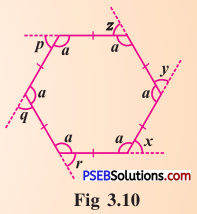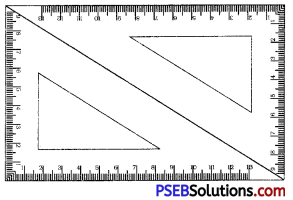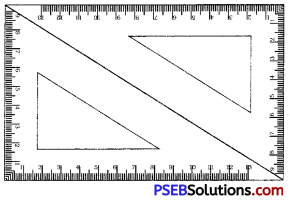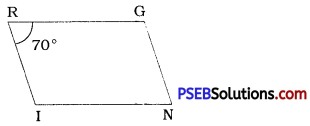Punjab State Board PSEB 8th Class Maths Book Solutions Chapter 3 Understanding Quadrilaterals InText Questions and Answers.
PSEB 8th Class Maths Solutions Chapter 3 Understanding Quadrilaterals InText Questions
Try These (Textbook Page No. 43)
Take a regular hexagon Fig 3.10.

Question 1.
What is the sum of the measures of its exterior angles x, y, z, p, q r?
Solution:
∠x + ∠y + ∠z + ∠p + ∠q + ∠r = 360°
(∵ Sum of exterior angles of a polygon = 360°)
Question 2.
Is x = y = z = p = q = r ? Why?
Solution:
Since, all the sides of the polygon are equal, it is a regular hexagon. So its interior angles are equal.
∴ x = (180° – a), y = (180° – a),
z = (180° – a), p = (180° – a),
q = (180° – a), r = (180° – a)
∴ x = y = z = p = q = r
![]()
Question 3.
What is the measure of each ?
(i) exterior angle
(ii) interior angle
Solution:
(i) x + y + z + p + q + r = 360°
(∵ Sum of exterior angles = 360°)
All angles are equal.
∴ Measure of each exterior angle = \(\frac{360^{\circ}}{6}\) = 60°
(ii) Exterior angle = 60°
∴ Interior angle = 180° – 60° = 120°.
Question 4.
Repeat this activity for the cases of:
(i) a regular octagon
(ii) a regular 20-gon
Solution:
(i) In a regular octagon, number of sides (n) = 8.
∴ Each exterior angle = \(\frac{360^{\circ}}{8}\) = 45°
∴ Each interior angle = 180° – 45° = 135°
(ii) For a regular 20-gon, the number of sides (n) = 20.
∴ Each exterior angle = \(\frac{360^{\circ}}{20}\) = 18°
∴ Each interior angle = 180° – 18° = 162°
![]()
Try These (Textbook Page No. 47)
Question 1.
Take two identical set squares with angles 30°-60°-90° and place them adjacently to form a parallelogram as shown in figure. Does this help you to verify the above property ?

Solution:
Yes, the given figure helps us to verify that opposite sides of a parallelogram are equal.
Try These (Textbook Page No. 48)
Question 1.

Solution:
Yes, this figure also helps us to confirm that opposite angles of a parallelogram are equal.
Think, Discuss and Write (Textbook Page No. 50)
Question 1.
After showing m∠R = m∠N = 70°, can you find m∠I and m∠G by any other method ?
Solution:

Yes, without using the property of parallelogram, we can find m∠I and m∠G.
m∠R = m∠N = 70° (Given)
RG || IN, the transversal RI intersecting them,
∴ m∠R + m∠I = 180° (Sum of interior angles is 180°)
∴ 70° + m∠I = 180° (∵ m∠R = m∠N = 70°)
∴ m∠I = 180° – 70°
∴ m∠I = 110°
Similarly, m∠G = 110°
![]()
Think, Discuss and Write (Textbook Page No. 56)
Question 1.
A mason has made a concrete slab. He needs it to be rectangular. In what different ways can he make sure that it is rectangular?
Solution :
He can make sure that it is rectangular using the following different ways :
- By making opposite sides of equal length.
- By keeping each angle at the corners as 90°.
- By keeping the diagonals of equal length.
- By making opposite sides parallel.
Question 2.
A square was defined as a rectangle with all sides equal. Can we define it as rhombus with equal angles? Explore this idea.
Solution:
Yes, because a rhombus becomes a square if its all angles are equal.
Question 3.
Can a trapezium have all angles equal ?
Can it have all sides equal ? Explain.
Solution:
Yes, a trapezium can have all angles equal. In this case, it becomes a square or rectangle.
Yes, it can have all sides equal. In this case, it becomes a rhombus or square.